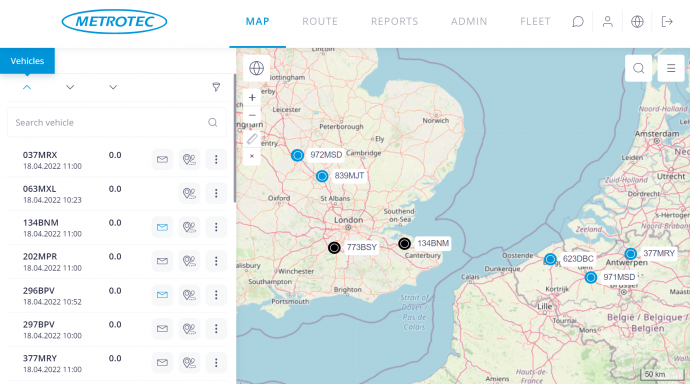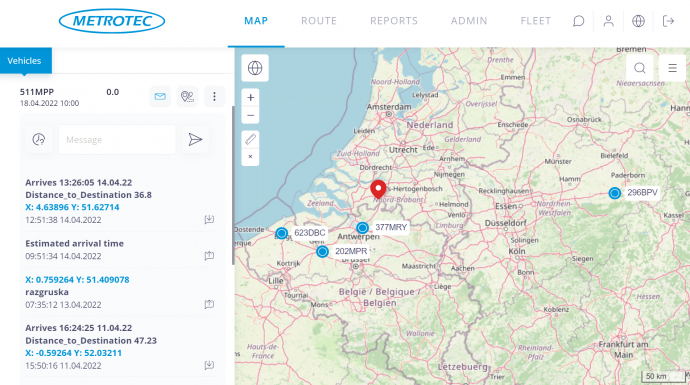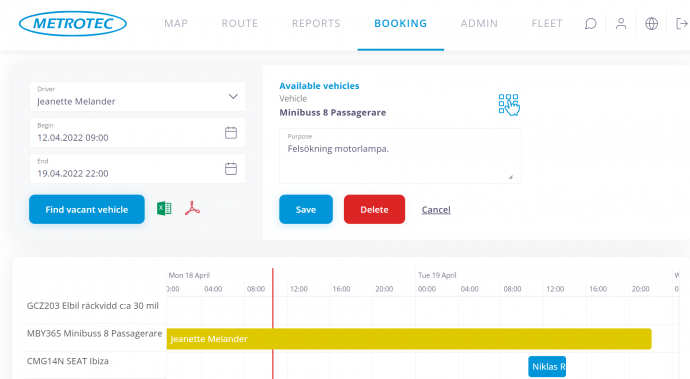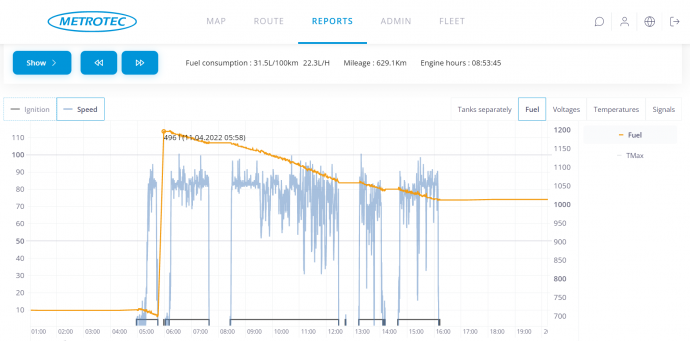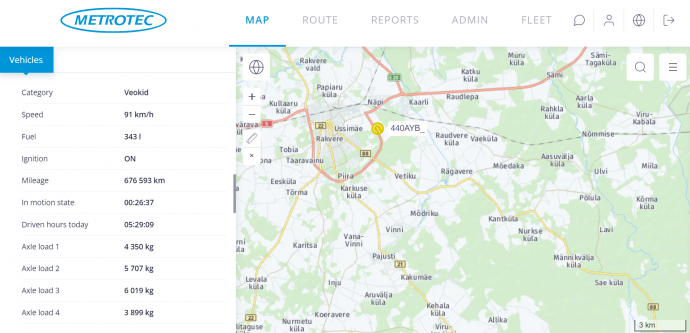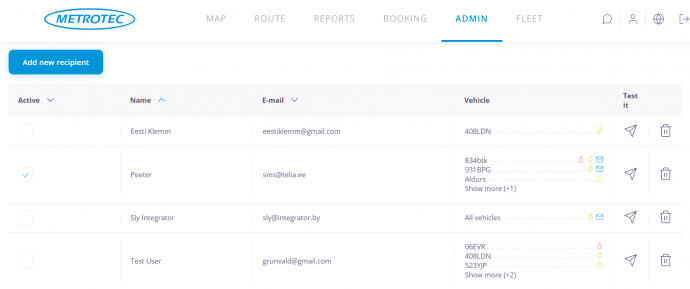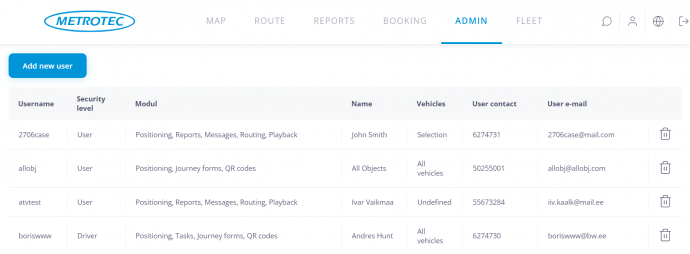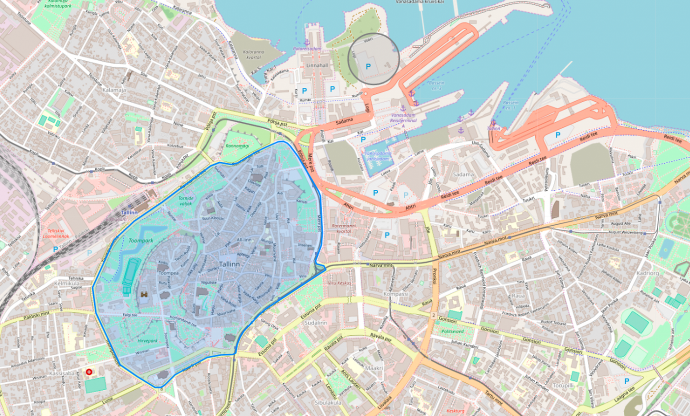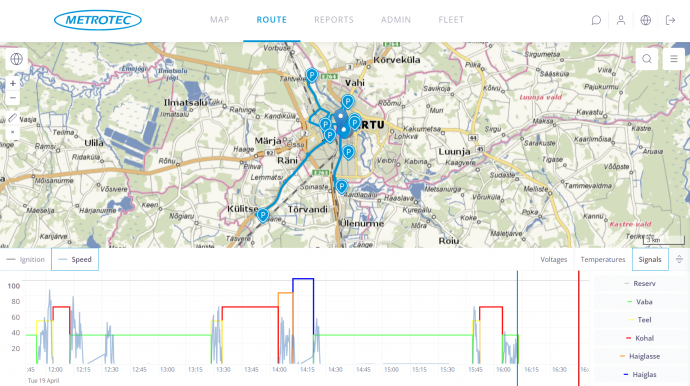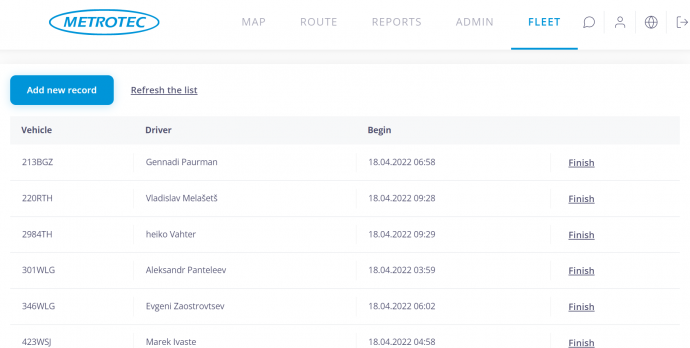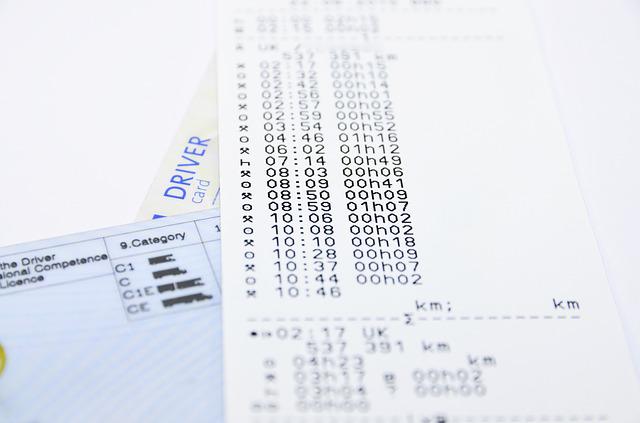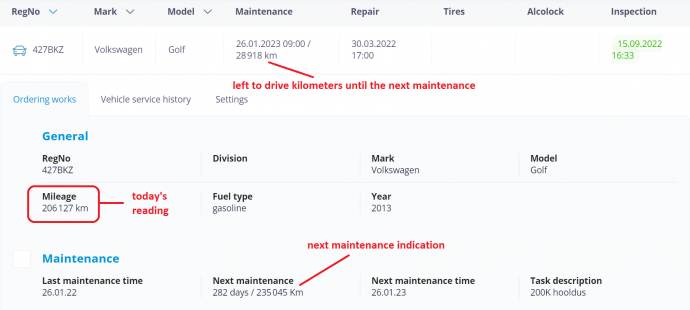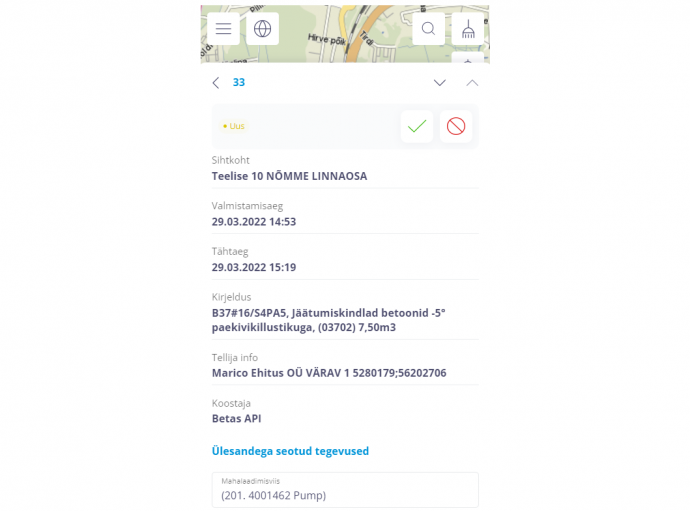F-Track web interface
F-Track provides the big picture of your vehicle fleet. Continuous, real time info about the location and busyness of individual vehicles allows for optimization and efficient planning as well as better coordination of drivers.

Positioning
- Continuous realtime info about location and tasks of vehicles
- Different base maps
- Searching the map
- Creating and managing POI’s
- Playback a route
Clear overview of the fleet – moving and standing, working and idle vehicles. Were the chosen route and speed optimal? How long it took to load a cargo? A route displayed on map provides exact answer. Even better – use playback and follow the route.
Two-way communication with drivers
- Garmin’s navigator
- Assigning tasks and destinations
- Estimated time of arrival
Garmin’s navigator, assigning tasks and destinations, estimated time of arrival .. Remotely controlled navigation terminal near drivers seat creates two-way data exchange between office and driver, including map support. A destination marker (POI) on a map in office is transferred with a mouseclick to the drivers navigation terminal. Maximal understanding through minimal effort! The driver accepts the task, navigation device guides the driver. The office sees, in addition to vehicles location and busyness, destination data and Estimated Time of Arrival. The yourney can be observed in real time. Precisely determined destinations save time and fuel. A task specified on map combined with navigation terminals directions makes drivers work simple and stress-free. In addition to automated messages, the navigation terminal enables two-way communication between office and driver. Simple and fast communication increases flexibility in reacting to events – from an unexpected job to a broken tire.
Booking
- Joint use of vehicles
- Booking of a vehicle for a certain driver for a certain, determined period
- Opening of the central locking from the driver’s phone during the period of the booking
Joint use is one of the options for optimization of the size of the vehicle fleet. The booking system allows the user to book a vehicle for an upcoming period and provides a good overview of the general use of the jointly used resource. Depending on the application of the device, the central locking and alarm system can be controlled from the user’s mobile phone during the period of the booking.
Graphs, tables, charts
- Simple and clear
- Dynamically scaled
Data is presented in comparative tables to increase clarity. Sort vehicles by fuel consumption, mileage or any other meter. A data presented as chart or graph obtains a new level of clearance. A moment explains what happens in vehicles fuel tank. Dynamic scale will present clearly a minuscule fuel loss.
Reporting
- Trip report
- Fuel consumption report
- Speed report
- Electronic driving diary
- .pdf, .xls, .csv eksport
F-Track system produces continuous high quality data stream by registring periodically readings from connected sensors, detecting changes in the readings and storing 24/7 movement history. Processing, filtering and concentrating this data provides users with different reports. The reports reflect driving, waiting and idle periods, work and rest time and movement speed as well as mileage, refueling, average fuel consumption per mileage and working hour. Interactive user interface enables odometer based task diary. User may export reports as needed in html, pdf, csv or xls formats.
Data from vehicles computer
- FMS standard for utility vehicles
- Appraisal of driving knacks and styles
- Acceleration, deceleration
- RPM
Acceleration, deceleration, use of cruise control, tachometer readings – they are all variables in the equatation of average fuel consumption. Everybody is trying to make sure, that fleet is exploited correctly and sustainably. Readings from on-board computer allow to appraise driving habits and proper maintenance.
Data export
- Integrating with different software platforms
- Analysing business process by F-Track system data
- Web service queries
F-Track system produces precise and reliable data. It is suitable for analysing business processes as well as payroll calculations. The data of F-Track system is compatible with value management software and accounting programs. F-Track API is a convenient tool for integrating with another info system. Formulate a query and “mine” quality data directly from our database be it working hours, mileage or something else. A little low level programming work and entire import is automatic and “tailor made”.
Alerting
- Operative informing if something is wrong
- SMS messages indicating fuel loss
- Reminder of maintenance
By creating and administering user accounts you can provide workers, business parners, clients, etc. with different levels of access to the data of F-Track system. Somebody wants a certain report about certain vehicle. Somebody wants to track a cargo. Somebody wants to see exact hours they were billed for. Flexible system of sub-accounts with different profiles and privileges combined with tying different users to different vehicles allows for taylor made customisation of access to data.
Users with different privileges
- Unlimited amout of sub-accounts
- Flexible setting
- Different levels of privileges
By creating and administering user accounts you can provide workers, business parners, clients, etc. with different levels of access to the data of F-Track system. Somebody wants a certain report about certain vehicle. Somebody wants to track a cargo. Somebody wants to see exact hours they were billed for. Flexible system of sub-accounts with different profiles and privileges combined with tying different users to different vehicles allows for taylor made customisation of access to data.
Geofence
- Polygonal or circular
- Visitation reports based on areas, points of interest, or countries
- Assembly notification in the event of arrival of several objects in one area
Circular or polygonal areas can be used to mark loading and unloading locations, mineral deposits, fields, or any other different territories on the map. Visitation reports of areas enable to conveniently count loads, measure the time spent on removing snow, ploughing, or providing another service.
The user can request to be notified of a higher than required number of vehicles assembling in a certain area.
Registration of work statuses
- Reporting of up to 19 different statuses
- Naming on the statuses as seen fit
- Addition of comments to each entry in the electronic journal
- Reported data can be presented to the party who ordered the service
- Accurate overview of the time spent, how long a certain mechanism was working or how long a certain work operation took to complete
- Registration of each work cycle including the name, beginning and ending times, duration, location, consumed fuel, passed distances
How long are the loading and idle times? How many kilometres are driven with no load? How high is the share of the journeys with no load in the total working time? The work statuses report provides accurate answers to all these questions.
It is often useful to divide the delivery or work process into sections and measure the duration of consecutive statuses. Measurement of the duration enables to understand, what the time was spent on. Based on the measured results, it is possible to assess the efficiency of the process, shape the price of the service, develop a motivating remuneration system, structure the work journal based on the registered statuses.
See also a useful article: “Registration of work statuses”
Identification of drivers
- Measurement of the working time spent outside of the office
- Recording of working time in the case of shift work
- Use of special machinery by different operators
- Handy driver-based reporting
Accurate recording of working time and driver-based reporting are both important functions. Seasonal works are usually performed in several shifts. It is quite common that special machinery is used by several different drivers. The machines are equipped with readers, which register the drivers’ chips. The codes of the chips are associated with the drivers in the database in the server. It is possible to check any time who is currently driving and who has been using a certain vehicle in a previous period.
Temperature mesuring
- Notification of detection of limit temperature
- Monitoring temperature in cargo space
- Use of up to 8 thermometers in one unit
- Temperature log for a customer of transport service
In several applications it is necessary to monitor temperature of the environment or to receive alarm upon detection of limit value of the temperature. Metrotec enables to use up to 8 thermometers with a single unit. Permissible total length of connection cables up to 40 m.
Diagrams show the dynamics of changes in the temperature during former data history. Data history indicates clearly, when a specific temperature was measured. Comparing it with the driving situation, location of the vehicle and data of on-board systems, it is possible to understand causes of any situations and mutually related circumstances.
Tachograph
- Automatic copying of the data of tachograph and driver’s card independently of the location of the driver and the vehicle
- Automatic archiving of data
- Web-based access to files
- Comprehensive reports of the operations, violations and mistakes of the driver
Notice of the event of copying of data in the tachograph
Proceeding from the law, the transporter is obliged to copy data from the tachograph once a quarter and from the driver’s card once a month. This task is well suitable for software. This removes the need to remember a bothersome obligation and spares time on account of performing of the operation. The user shall specify a period for each vehicle, upon expiration of which data are copied and archived automatically. Notice of downloading will also remain in the tachograph. Detailed reports are always available in the web.
Maintenance diary
Helps you keep track of completed, scheduled and future tasks
- Booking of slots for technical maintenance, roadworthiness inspections, repairs, tyre changes
- Highlights equipment particulars when scheduled maintenance is coming up or a maintenance slot needs to be booked
- Allows automatic alerts based on preset maintenance periods
- Keeps track of where a vehicle’s tyres are stored and of their state of wear
- Keeps track of the mileage or operating hour reading at which a specific repair or maintenance was performed
- Provides a full list of maintenance documents – photos, invoices, offers – always accessible to all parties involved
- Systematised data – easy to search and quickly found
The maintenance module is intended for managing the technical maintenance of various equipment. This includes repairs, maintenance, vehicle tyre changes, roadworthiness inspections. The history of equipment maintenance often becomes muddled. This is compounded by the fact that in addition to being numerous, vehicle fleets also tend to include widely varying units, and repairs or maintenance of specific components may be performed exclusively at specialized repair shops. Often, tyres too are stored at various different locations. The maintenance module will put all of this to order. It will help you book maintenance slots and provide corresponding alerts. It will also keep a history of maintenance operations complete with the requisite documentation and photos. The module will keep all parties up to date as to when a certain component was serviced and where a vehicle’s tyres are stored.
Read more about maintenance diary here.
Digital worksheet
- Overview of performed job operations and of their duration
- Automatic GPS tracking information (mileage, addresses)
- Flexible management of job operations for each vehicle
- Simple and easy to use
- Precise and transparent invoicing information
Daily report with a list of job operations. Quick overview of what was done, how much time it took and how much mileage was involved. Driver-side use is simple – select a job from the list and hit ‘Completed’ when done. The result is a sleek diary in which the GPS unit has added covered mileage or clocked-up operating hours to each entry. Depending on the particular version installed or the type of your equipment, it is possible to add fuel expenditure, the number of times the load bed was tipped, the address, driving time with/without load, etc. There are many options.
Tasks
- A tool for the driver, shipping dispatcher, accountant
- Clearly states destination, turnover time, task, customer’s contacts
- Navigation aid to destination
- Online indication of job completion status for the logistician
- Viewing and adding of documents and photos
- Electronic signature acknowledging receipt of goods or supply of services
- Shipment tracking function for the customer
A central register of jobs serves the needs of the shipping dispatcher, driver and accountant equally well.
The shipping dispatcher sets the tasks and assigns them to specific vehicles. Logisticians can see which are new tasks, which tasks are in progress, completed, unsuccessful or cancelled. Office staff can add photos or files to the taskings, change task scheduling and the people responsible. The driver sees the tasks assigned to them and can use the application as a navigation aid to destination, view the files attached to the job and set its status as ‘In progress’, ‘Completed’ or ‘Unsuccessful’.
When tasks are combined with the digital worksheet, the result is a report that shows what was planned and also reflects what actually took place.
Since customers have different needs, there are different versions of the application, based on different approaches to task setting and subsequent reporting.
Read more about tasks here.

